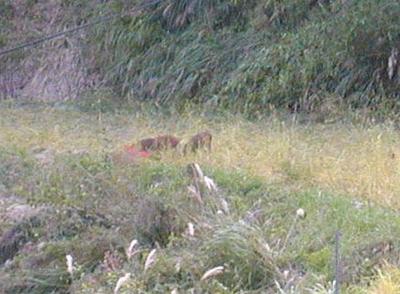morning prayers -
the graves of the ancestors
in deep silence

|
:::::::::::::::::::::::::::::::::::::::::::::::::::::::::::::::::::::::::::::::::::::::::::::::::::::
My Haiku Friend Allison wroteThe only thing that caught my eye and took it away from the graves is the slightly yellow 'thing' to the left of the main tree, by the driveway. I don't know what it is, but if you cloned it out, it wouldn't be there to distract me. I know it's a 'little thing', but I really want to focus on the headstones . . . and the rest of your photo (with the gorgeous lighting) pulls my focus right where it belongs.
So she made this lovely haiga for me !

|
Dear Allison,
thanks for your great effort.
It looks terrific and it made me think ...
I try to write haiku about WHAT IS without judgement and my photos show WHAT IS without interference and retouching (is that the right word?)
Japanese landscape is full of wires and electricity poles and all that, just this morning (speak of coincidence) was an article in the Japan times about
UGLY JAPAN (see below)
When I take our landscape photos, I try to avoid these wires and poles, but sometimes it just can not be done ... so I guess it my modern haiku reality to live with them.
If I write normal poetry and paint a landscape, I am free to transform it as I please, but with my haiku, there is a difference.
I hang on to external and internal shasei, sketching from nature and the inspiration of moment.
Thanks for bringing this home once again.
And thanks for showing the "joys and dangers" of interferring with a photo.
What is reality? quite a question now for me !
morning prayers ..
the fence poles and the graves
in deep silence
GABI
:::::::::::::::::::::::::::::::::::::::::::::::::::::::::::::::::::::::::::::::::::::::::::::::::::::
© Japan Times, KEVIN RAFFERTY, Feb.28, 2008
Why's Japan grown so ugly?
By KEVIN RAFFERTY
YUNOMINE, Wakayama Pref. —
My brother wanted to create a new room in the loft of his house in an English provincial city, actually Kingston upon Hull (population 250,000), a place of passing interest to Japanese because two centuries ago it was one of the world's biggest whaling ports. Today, the whales are still present, singing their haunting songs in a museum to the city's maritime history.
The local council refused him permission because the room would have required the insertion of a new window, and that would have ruined the uniform roofline of the avenue where he lives.
I was thinking of this when traveling recently from Osaka to the onsen town of Yunomine, an exhilarating journey along through the mountains of the Kii Peninsula. This is Japan's historic heartland, where the gods had their origins, and these routes have been a place of pilgrimage for a thousand years, through which people have sought self-discovery, purification and healing.
Winter had laid its icy fingers across the land, and the green hillsides were liberally dusted with snow. From time to time we diced with the ice on the narrow old Kumano road and we made several detours on foot along the ancient Kumano way, which meanders up and down the uneven contours of the hills.
But the journey was spoiled by the dreadful depredations that human beings have visited on a beautiful land. Even on the ancient footpath, it is hard to get away from the despoliation of modern life, with the natural shades of green sliced up by silver wires held together by the ugly modern gods of electricity pylons.
On the old road, carefully engineered to follow the twists and turns of the contours of the natural environment, the encroachment of what is termed civilization comes threateningly closer. In places it is hard to hear the birds and insects, let alone the gurgling of mountain streams or the sounds of the wind talking to the grass and trees, above the roar of traffic on the modern road.
That road — and more so the toll roads that go directly through from Osaka to Kumano — shows the contempt that modern Japanese bureaucrats, and their political and corporate construction allies, have for the natural environment. They have bulldozed remorselessly across the countryside and gouged deep wounds through the hills. Where nature has hit back with the threat of landslides, the construction companies have tried to suffocate it by plastering hillsides with concrete.
Alex Kerr in "Dogs and Demons" (2001) documented the grip of the deadly concrete disease on Japan, with 97 percent of rivers dammed and 60 percent of the coastline covered in concrete, not to speak of 43 percent of native forests replanted with allergy-bearing and wildlife-free cedar plantations.
Where is the traditional Japanese love of nature, beauty, gentleness, nuance? All damned and dammed with concrete.
But it gets worse as you venture into remote rural areas, which in other countries offer a refuge from the pressures of hectic modern life. Kerr complained of Japan's "Hello-Kitty-fied" culture. Hello Kitty has a cuteness, but Japan's rural life is plain plug ugly. In every small town, ugliness is rampant: bright signs with mindless slogans; garish advertisements for pachinko parlors; giant banners for used cars; loud screaming posters for every tin-pot business; and of course wires everywhere, as if the spiders are taking over.
Try to take a photograph of what should be a picturesque place. You find wires everywhere, of course: at high and low level, from afar or close to, every view is spoiled. Tasteful traditional wooden houses sit next to tasteless modern monstrosities; exposed metal and plastic pipes scar the scene, some of them leaking; everyone and anyone can put up a banner; concrete is ubiquitous, some of it masquerading as wood; and ugly robotic machines parade the main street dispensing cigarettes or soft drinks. Shops sell over-wrapped over-priced tacky souvenirs (but no bath salts that I could see).
Anyone who has been to Kyoto or Nara or on the road between them is assaulted by the horrors of Japanese town planning.
What is worse is how ugliness has penetrated Japan's historic heartland, and no one seems to care.
Mikako Hayashi, associate professor of restorative dentistry and endodontology at Osaka University, remembers her return to Japan after 16 months doing research at England's Manchester University and exploring the historic spots there. She says: "As the aircraft banked on its final approach, I looked out of the window to see the countryside of my homeland — and it looked as if some demon giant had tipped a huge garbage can over the landscape."
This is surely an appalling thing to say about a country whose people have traditionally taken great pride in being in harmony with nature. But Hayashi believes that there is no point merely in lamenting modern ugliness; she suggests that it is time to do something about it.
In England there is a keenly fought annual competition for the Best Kept Village. It is time for Japan to do something similar, Hayashi suggests: "Japan should be more ambitious: choose the prettiest or most picturesque village and town. Give points for a pleasant skyline, for special features, for good taste or neatness according to a scale: deduct points, say five points off for offensive advertising, 20 points off for a pachinko parlor on main street, 30 or more for ugly buildings that do not blend."
She is being too ambitious. If such a competition were held today on such a basis, the winner would probably be a place with a score of minus several hundred.
You do not have to go all the way of Britain, where one department of a London council insisted that a diseased cherry tree must be chopped down, but another said if it were cut the owner would be fined for altering the skyline.
Hayashi's idea would help develop tourism, both domestic and foreign, and — in a small but important way — teach Japanese to value their precious land and environment. Newly attractive towns and villages may be able to attract back people and jobs. Smothering the land in concrete wastes money and kills ideas, ideals and beauty. Eventually, maybe, the vital message can filter through from the ordinary people of Japan back to the ishiatama bureaucrats and politicians.
:::::::::::::::::::::::::::::::::::::::::::::::::::::::::::::::::::::::::::::::::::::::::::::::::::::
More of my SNOW HAIKU
SNOW in Paradise
Internal shasei ...
Environment and emotion: keijo (keijoo 景情 けいじょう)
. . . Read my Haiku Archives 2008
:::::::::::::::::::::::::::::::::::::::::::::::::::::::::::::::::::::::::::::::::::::::::::::::::::





















